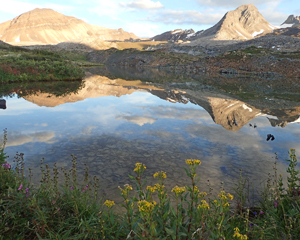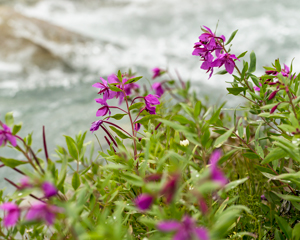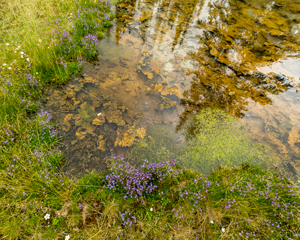
© Jenny George
Plants
Nááts'įhch'oh National Park Reserve
The landscapes of Nááts’įhch’oh National Park Reserve are home to nearly 200 identified species of vascular plants, in addition to a wide variety of mosses and lichens. From mountaintops to valley bottoms, diverse habitats support unique and beautiful examples of subarctic vegetation. Note that harvesting of plants and plant parts within park boundaries is only permitted by local Indigenous traditional users.
Plants serve intrinsic roles within their environments. They influence – and are affected by – animals, local climate, underlying rocks and soils, and water regimes. Together, these intricate relationships define the park’s ecosystems. Plants stabilise rocky slopes, produce oxygen, and provide food sources for herbivorous animals like moose and caribou.
The park’s northern latitude and mountainous location affect growing conditions for vegetation in fundamental ways. Not far from the Arctic Circle, the park has great seasonal differences in light availability. The dark winter months bring extreme cold and a deep snowpack, but long daylight hours in the summer help plants to grow and reproduce quickly. This is especially true on south-facing slopes, which receive the most direct sunlight. Elevation also determines where plant species can be found; high in the mountains, cold winds and low temperatures exclude all but the hardiest species, while valleys buffer harsh weather and provide sheltered areas for diverse plant communities to thrive.
The park’s terrestrial ecosystems can be divided into four broad categories, each distinguished by the species and conditions that exist there.
Alpine

Rugged mountain ridges and alpine meadows feature species that are hardy enough to persist under difficult growing conditions. Snow can fall during any month of the year in the mountains, giving alpine plants a particularly short season to grow and reproduce. They must be able to anchor themselves well in shallow, rubbly soils in order to endure high winds and rock falls and reproduce quickly during the short summer season.
Hiking up to these higher elevations during the summer months provides an opportunity to see wildflowers like white mountain avens, mountain harebell, Lapland rosebay, and pink mountain heather. Nodding campion and inky blue gentian feature particularly delicate and unique flowers. These alpine blossoms peak during the month of July and fill mountain slopes with vibrant colour. Though few trees exist in these environments, stunted subalpine firs sometimes grow in depressions and on slopes protected from prevailing winds. The tangled, stout growth forms they have at these elevations are known as krummholtz, a German term meaning “crooked wood”
Sub-alpine forest

Sheltered areas below the alpine zone permit denser growth of trees and other plants. At the upper margin of this zone, shrubs like dwarf birch create dense thickets that are punctuated by sentinel-like firs. Caribou visit these areas while foraging, searching for thick patches of ground lichens. Forests farther down into the valleys feature lush groves of black and white spruce. Their understory includes shrubby plants like willows and Labrador tea, as well as an array of wildflowers.
Blossoming begins early here; flowers are most numerous in June and many species have finished by early August. Paddlers and hikers travelling through forested zones are likely to see river beauty, mountain larkspur, Arctic lupine, and fireweed. Orchids, such as the sparrow’s-egg lady’s-slipper and green bog orchid, grow in moist, shady areas.
Toward the end of the summer, fruits like blueberries, bog cranberries, wild currants, and gooseberries ripen, and bears eat them in earnest to prepare for hibernation. Hillside carpets of dwarf birch go through a magnificent colour transition through red and orange hues in the autumn, while aspen and poplar trees add bursts of golden yellow to the landscape.
Wetlands

Plant communities in these moist environments are well adapted to waterlogged soils with low dissolved oxygen levels. Several sedge and willow species thrive here; sometimes they grow on floating mats of vegetation that are also dense with spongy mosses. Raised hummocks often support copses of black spruce trees, whose roots can tolerate wetter soils. Arctic dock, alpine bistort, common palustre, yellow thimbleweed, and Arctic starflower bloom close to the water’s edge during the summer. A carnivorous plant, the common butterwort, also grows in these damp environments.
Enjoy these wetland ecosystems at Nááts’įhch’oh Tué (Moose Ponds), where a network of beaver dams has created a series of ponds, pools, and channels. Verdant vegetation forms a backdrop for observing moose, beaver, and caribou, as well as an abundance of migratory bird species.
Geothermal areas

Hot springs in the park are sources for warm, mineral-rich water that creates unique micro-ecosystems. At Sadéé Shúh Gaǫfáá (Sunlight Mountain Hot Spring) and Pı̨́ı̨́p'enéh łéetǫ́ǫ́ Gaǫfáá (Broken Skull Hot Spring), a profusion of flowering species like bog lobelia, yellow rattle, starry false Solomon’s seal, and death camas grow around hot pools. Sadéé Shúh Gaǫfáá is the only known location in the Northwest Territories where Prunella vulgaris (Heal-All or Self-Heal) can be found.
Tread lightly when visiting these special plant communities, leaving them intact so that other visitors may have the same enjoyable experience while they enjoy a relaxing soak.
Related links
- Date modified :